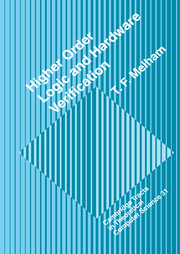7 - Abstraction between Models
Published online by Cambridge University Press: 21 January 2010
Summary
This chapter gives an example to illustrate the idea of an abstraction relationship between two hardware models which was introduced in chapter 4. The two models considered are the threshold switching model of CMOS transistor behaviour defined in chapter 5 and the simpler switch model defined in chapter 2.
Both of these models of the CMOS technology are, of course, abstractions of the physical reality they represent, and both models are therefore bound to be inaccurate in some respects. But the switch model is also an abstraction of the threshold switching model, in the sense that both models describe the same set of primitive components—power, ground, N-type and P-type transistors—but the switch model presents a more abstract view of these components. The threshold switching model reflects the fact that real CMOS transistors do not pass both logic levels equally well. But in the more abstract (and therefore simpler) switch model, this aspect of transistor behaviour is ignored.
The switch model is less accurate than the threshold switching model; a circuit that can be proved correct using the switch model may in fact be incorrect according to the threshold switching model. For certain circuits, however, the two models are effectively equivalent. For these circuits, a proof of correctness in the switch model amounts to a proof of correctness in the threshold switching model. The switch model is an adequate basis for verification of these circuits, and the extra accuracy of the more complex threshold switching model is not needed.
- Type
- Chapter
- Information
- Higher Order Logic and Hardware Verification , pp. 129 - 146Publisher: Cambridge University PressPrint publication year: 1993



